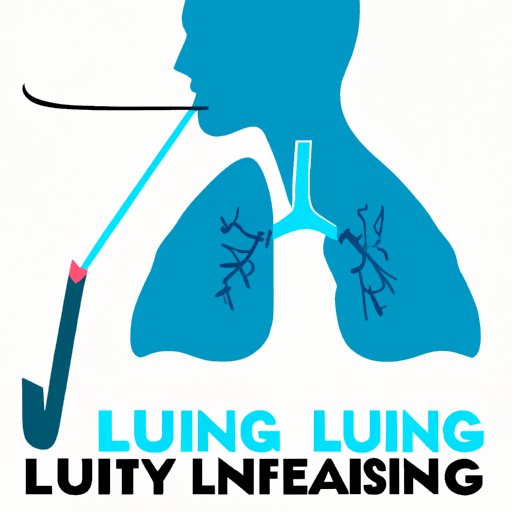Introduction
Your lungs play a vital role in your overall health, delivering oxygen to your body and removing carbon dioxide. Smoking is one of the biggest causes of lung damage, leading to chronic obstructive pulmonary disease (COPD), lung cancer, and other serious respiratory conditions. The good news is that quitting smoking is the single best thing you can do for your lung health.
The purpose of this article is to provide tips and strategies for improving your lung health after quitting smoking. We will cover the importance of exercise, healthy eating, breathing exercises, avoiding pollutants, and getting regular check-ups.
Incorporate regular physical activity into your routine
Regular exercise can help improve lung function and reduce the risk of lung disease. Some of the benefits of exercise for lung health include:
- Strengthening the muscles used for breathing
- Increasing lung capacity
- Reducing inflammation in the lungs
There are many different types of physical activity that can benefit your lung health, including:
- Walking
- Cycling
- Swimming
- Yoga
To incorporate exercise into your daily routine, try:
- Taking the stairs instead of the elevator
- Going for a 10-minute walk after a meal
- Doing yoga or stretching exercises in the morning
Adopt a healthy diet
Nutrition plays a crucial role in repairing lung damage. Eating a healthy, balanced diet can help reduce inflammation, improve lung function, and reduce the risk of lung disease. Some foods that are particularly beneficial for lung health include:
- Fruits and vegetables, which are high in antioxidants and vitamins
- Whole grains, which are high in fiber and can help reduce inflammation
- Lean proteins, such as fish and poultry, which can help maintain muscle strength and reduce inflammation
Here are some meal ideas and recipes that incorporate these lung-healthy foods:
- Oatmeal with berries and walnuts
- Grilled chicken with roasted vegetables
- Lentil soup with whole grain bread
Quit smoking
Quitting smoking is the most important thing you can do for your lung health. When you quit smoking, your lung function begins to improve immediately, and your risk of developing lung disease decreases over time. There are many different strategies you can use to quit smoking, including:
- Nicotine replacement therapy (NRT), such as patches or gum
- Prescription medications, such as bupropion and varenicline
- Counseling or support groups
There are also many resources available to help you quit smoking, including the National Cancer Institute’s Quitline (1-877-44U-QUIT) and Smokefree.gov.
Use breathing exercises
Breathing exercises can help strengthen your lungs and improve respiratory function. Two effective breathing exercises for improving lung health are pursed-lip breathing and diaphragmatic breathing.
Pursed-lip breathing
Pursed-lip breathing involves exhaling through pursed lips, as if you were blowing out a candle. Here’s how to do it:
- Breathe in through your nose for two seconds.
- Pucker your lips as if you were going to whistle or blow out a candle.
- Exhale slowly through your pursed lips for four seconds.
- Repeat for several breaths.
Diaphragmatic breathing
Diaphragmatic breathing involves breathing deeply from your diaphragm, rather than shallowly from your chest. Here’s how to do it:
- Lie down on your back or sit comfortably in a chair.
- Place one hand on your chest and one hand on your belly.
- Breathe in slowly through your nose, feeling your belly rise and expand.
- Exhale slowly through your mouth, feeling your belly fall inward.
- Repeat for several breaths.
Avoid exposure to pollutants
Air pollution can exacerbate lung damage and increase the risk of lung disease. To avoid exposure to pollutants:
- Avoid smoking areas and secondhand smoke.
- Wear a mask in polluted areas.
- Use air filters and purifiers in your home.
Get regular check-ups
Regular lung check-ups are an important part of maintaining lung health, especially if you have a history of smoking. During a lung check-up, your doctor may perform tests such as spirometry, which measures lung function. They may also recommend additional tests or treatments based on your individual needs.
To find a doctor who specializes in lung health, you can search for pulmonologists in your area or ask for a referral from your primary care physician.
Conclusion
Improving lung health after quitting smoking is a gradual process, but with the right strategies and resources, it is possible to improve your lung function and reduce your risk of lung disease. By incorporating regular physical activity, adopting a healthy diet, quitting smoking, using breathing exercises, avoiding pollutants, and getting regular check-ups, you can take proactive steps towards a healthier future. Remember, every step you take towards improving your lung health is a step in the right direction.
(Note: Is this article not meeting your expectations? Do you have knowledge or insights to share? Unlock new opportunities and expand your reach by joining our authors team. Click Registration to join us and share your expertise with our readers.)
